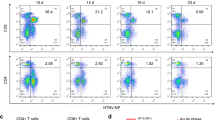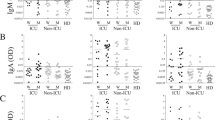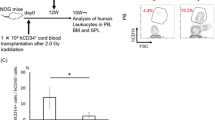Abstract
Ebola virus is very pathogenic in humans. It induces an acute hemorrhagic fever that leads to death in about 70% of patients1. We compared the immune responses of patients who died from Ebola virus disease with those who survived during two large outbreaks in 1996 in Gabon. In survivors, early and increasing levels of IgG, directed mainly against the nucleoprotein and the 40-kDa viral protein, were followed by clearance of circulating viral antigen and activation of cytotoxic T cells, which was indicated by the upregulation of FasL, perforin, CD28 and gamma interferon mRNA in peripheral blood mononuclear cells. In contrast, fatal infection was characterized by impaired humoral responses, with absent specific IgG and barely detectable IgM. Early activation of T cells, indicated by mRNA patterns in peripheral blood mononuclear cells and considerable release of gamma interferon in plasma, was followed in the days preceding death by the disappearance of T cell-related mRNA (including CD3 and CD8). DNA fragmentation in blood leukocytes and release of 41/7 nuclear matrix protein in plasma indicated that massive intravascular apoptosis proceeded relentlessly during the last 5 days of life. Thus, events very early in Ebola virus infection determine the control of viral replication and recovery or catastrophic illness and death.
This is a preview of subscription content, access via your institution
Access options
Subscribe to this journal
Receive 12 print issues and online access
$209.00 per year
only $17.42 per issue
Buy this article
- Purchase on Springer Link
- Instant access to full article PDF
Prices may be subject to local taxes which are calculated during checkout



Similar content being viewed by others
References
Peters, C.J. & Khan, A.S. in Current Topics in Microbiology and Immunology Vol. 235 (ed. Klenk, H.-D.) 85– 95 (Springer-Verlag, Berlin, 1999).
Ksiazek, T.G. et al. Enzyme immunosorbent assay for Ebola virus antigens in tissues of infected primates. J. Clin. Microbiol. 30, 947–950 (1992).
Xu, L. et al. Immunization for Ebola virus infection. Nature Med. 4, 37–42 (1998 ).
Clark, E.A. & Ledbetter, J.A. How B and T cells talk to each other. Nature 367, 425– 428 (1994).
Lowin, B., Hahne, M., Mattmann, C. & Tschopp, J. Cytolytic T-cell cytotoxicity is mediated through perforin and Fas lytic pathways. Nature 370, 650–653 ( 1994).
Kayagaki, N. et al. Metalloproteinase-mediated release of human Fas ligand. J. Exp. Med. 182, 1777–1783 (1995).
Kiener, P.A. et al. Human monocytic cells contain high levels of intracellular Fas ligand. Rapid release following cellular activation. J. Immunol. 159, 1594–1598 ( 1997).
Feldmann, H. et al. Filovirus-induced endothelial leakage triggered by infected monocytes/macrophages. J. Virol. 70, 2208 –2214 (1996).
Kroemer, G. The proto-oncogen Bcl-2 and its role in regulating apoptosis. Nature Med. 3, 614–620 ( 1997).
Miller, T., Beausang, L.A., Meneghini, M. & Lidgard, G. Death-induced changes to the nuclear matrix: the use of anti-nuclear matrix antibodies to study agents of apoptosis. Biotechniques 15, 1042–1047 (1993).
Jeon, S.H. et al. Expression of Tcf-1 mRNA and surface TCR-CD3 complexes are reduced during apoptosis of T cells. Int. Immunol. 10, 1519–1527 (1998).
Fisher-Hoch, S.P. et al. Pathophysiology of shock and hemorrhage in a fulminating viral infection (Ebola). J. Inf. Dis. 152, 887–894 (1985).
Baskerville, A., Bowen, E.T., Platt, G.S., McArdell, L.B. & Simpson, D.I. The pathology of experimental Ebola virus infection in monkeys. J. Pathol. 125, 131– 138 (1978).
Baskerville, A., Fisher-Hoch, S.P., Neild, G.H. & Dowsett, A.B. Ultrastructural pathology of experimental Ebola haemorrhagic fever virus infection. J. Pathol. 147, 199–209 (1985).
Jaax, N.K. et al. Lethal experimental infection of rhesus monkeys with Ebola-Zaire (Mayinga) virus by the oral and conjunctival route of exposure. Arch. Pathol. Lab. Med. 120, 140–155 (1996).
Johnson, E., Jaax, N., White, J. & Jahrling, P. Lethal experimental infections of rhesus monkeys by aerosolized Ebola virus. Int. J. Exp. Pathol. 76, 227–236 (1995).
Yang, Z.-Y. et al. Distinct cellular interactions of secreted and transmembrane Ebola virus glycoproteins. Science. 279, 1034–1037 (1998).
Zaki, S.R., Greer, P.W., Goldsmith, C.S. & Coffield, L.M. in International Colloquium on Ebola Virus Research (Institute of Tropical Medicine, Antwerp, Belgium, 1996).
Gallimore, A. et al. Induction and exhaustion of lymphocytic choriomeningitis virus-specific cytotoxic T lymphocytes visualized using soluble tetrameric major histocompatibility complex class I-peptide complexes. J. Exp. Med. 1383–1393 (1998 ).
Suda, T., Hashimoto, H., Tanaka, M., Ochi, T. & Nagata, S. Membrane Fas ligand kills human peripheral blood T lymphocytes, and soluble Fas ligand blocks the killing. J. Exp. Med. 186, 2045–2050 (1997).
Tanaka, M., Itai, T., Adachi, M. & Nagata, S. Downregulation of Fas ligand by shedding. Nature Med. 4, 31–36 (1998).
Georges-Courbot, M.C. et al. Isolation and phylogenetic characterization of Ebola viruses causing different outbreaks in Gabon. Emerg. Infect. Dis. 3 , 59–62 (1997).
WHO. Recommendations for management of viral haemorrhagic fevers in Africa, in Workshop on Viral Haemorrhagic Fevers (Sierra Leone, 1985).
Feldmann, H., Nichol, S.T., Schikore, M., Slenczka, W. & Klenk, H.-D. Glycosylation and oligomerization of the spike protein of Marburg virus. Virology 182 , 353–356 (1991).
Acknowledgements
We are grateful to C. Tevi-Benissan and P. Tshipamba for their assistance on fieldwork, and A. Pendy, B. Pambo and P. Obiang for access to patient specimens. We also thank V.E. Volchkov, P.E. Rollin and T.G. Ksiazek for providing Ebola-specific reagents and for their assistance with western blot analysis and IgM detection. S.B. is supported by a grant from the Ministère de la Recherche et de l'Enseignement Supérieur (France). CIRMF is supported by the state of Gabon, ELF-Gabon and the Ministère de la Coopération Française.
Author information
Authors and Affiliations
Corresponding authors
Rights and permissions
About this article
Cite this article
Baize, S., Leroy, E., Georges-Courbot, MC. et al. Defective humoral responses and extensive intravascular apoptosis are associated with fatal outcome in Ebola virus-infected patients. Nat Med 5, 423–426 (1999). https://doi.org/10.1038/7422
Received:
Accepted:
Issue Date:
DOI: https://doi.org/10.1038/7422
This article is cited by
-
T cell apoptosis characterizes severe Covid-19 disease
Cell Death & Differentiation (2022)
-
Immune response in COVID-19: what is next?
Cell Death & Differentiation (2022)
-
Low quantity and quality of anti-spike humoral response is linked to CD4 T-cell apoptosis in COVID-19 patients
Cell Death & Disease (2022)
-
Chloroquine and hydroxychloroquine in the treatment of COVID-19: the never-ending story
Applied Microbiology and Biotechnology (2021)
-
Ebola virus disease
Nature Reviews Disease Primers (2020)



